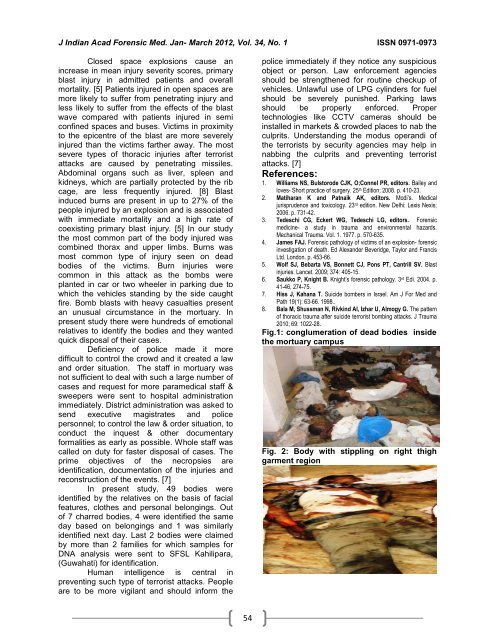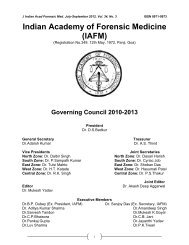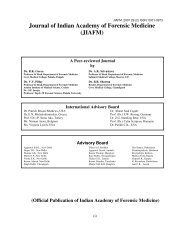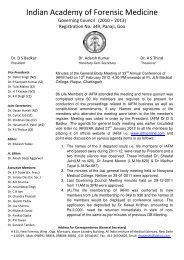Indian Academy of Forensic Medicine (IAFM) - Official website of IAFM
Indian Academy of Forensic Medicine (IAFM) - Official website of IAFM
Indian Academy of Forensic Medicine (IAFM) - Official website of IAFM
You also want an ePaper? Increase the reach of your titles
YUMPU automatically turns print PDFs into web optimized ePapers that Google loves.
J <strong>Indian</strong> Acad <strong>Forensic</strong> Med. Jan- March 2012, Vol. 34, No. 1 ISSN 0971-0973<br />
Closed space explosions cause an<br />
increase in mean injury severity scores, primary<br />
blast injury in admitted patients and overall<br />
mortality. [5] Patients injured in open spaces are<br />
more likely to suffer from penetrating injury and<br />
less likely to suffer from the effects <strong>of</strong> the blast<br />
wave compared with patients injured in semi<br />
confined spaces and buses. Victims in proximity<br />
to the epicentre <strong>of</strong> the blast are more severely<br />
injured than the victims farther away. The most<br />
severe types <strong>of</strong> thoracic injuries after terrorist<br />
attacks are caused by penetrating missiles.<br />
Abdominal organs such as liver, spleen and<br />
kidneys, which are partially protected by the rib<br />
cage, are less frequently injured. [8] Blast<br />
induced burns are present in up to 27% <strong>of</strong> the<br />
people injured by an explosion and is associated<br />
with immediate mortality and a high rate <strong>of</strong><br />
coexisting primary blast injury. [5] In our study<br />
the most common part <strong>of</strong> the body injured was<br />
combined thorax and upper limbs. Burns was<br />
most common type <strong>of</strong> injury seen on dead<br />
bodies <strong>of</strong> the victims. Burn injuries were<br />
common in this attack as the bombs were<br />
planted in car or two wheeler in parking due to<br />
which the vehicles standing by the side caught<br />
fire. Bomb blasts with heavy casualties present<br />
an unusual circumstance in the mortuary. In<br />
present study there were hundreds <strong>of</strong> emotional<br />
relatives to identify the bodies and they wanted<br />
quick disposal <strong>of</strong> their cases.<br />
Deficiency <strong>of</strong> police made it more<br />
difficult to control the crowd and it created a law<br />
and order situation. The staff in mortuary was<br />
not sufficient to deal with such a large number <strong>of</strong><br />
cases and request for more paramedical staff &<br />
sweepers were sent to hospital administration<br />
immediately. District administration was asked to<br />
send executive magistrates and police<br />
personnel; to control the law & order situation, to<br />
conduct the inquest & other documentary<br />
formalities as early as possible. Whole staff was<br />
called on duty for faster disposal <strong>of</strong> cases. The<br />
prime objectives <strong>of</strong> the necropsies are<br />
identification, documentation <strong>of</strong> the injuries and<br />
reconstruction <strong>of</strong> the events. [7]<br />
In present study, 49 bodies were<br />
identified by the relatives on the basis <strong>of</strong> facial<br />
features, clothes and personal belongings. Out<br />
<strong>of</strong> 7 charred bodies, 4 were identified the same<br />
day based on belongings and 1 was similarly<br />
identified next day. Last 2 bodies were claimed<br />
by more than 2 families for which samples for<br />
DNA analysis were sent to SFSL Kahilipara,<br />
(Guwahati) for identification.<br />
Human intelligence is central in<br />
preventing such type <strong>of</strong> terrorist attacks. People<br />
are to be more vigilant and should inform the<br />
54<br />
police immediately if they notice any suspicious<br />
object or person. Law enforcement agencies<br />
should be strengthened for routine checkup <strong>of</strong><br />
vehicles. Unlawful use <strong>of</strong> LPG cylinders for fuel<br />
should be severely punished. Parking laws<br />
should be properly enforced. Proper<br />
technologies like CCTV cameras should be<br />
installed in markets & crowded places to nab the<br />
culprits. Understanding the modus operandi <strong>of</strong><br />
the terrorists by security agencies may help in<br />
nabbing the culprits and preventing terrorist<br />
attacks. [7]<br />
References:<br />
1. Williams NS, Bulstorode CJK, O;Connel PR, editors. Bailey and<br />
loves- Short practice <strong>of</strong> surgery. 25 th Edition; 2008. p. 410-23.<br />
2. Matiharan K and Patnaik AK, editors. Modi’s. Medical<br />
jurisprudence and toxicology. 23 rd edition. New Delhi: Lexis Nexis;<br />
2006. p. 731-42.<br />
3. Tedeschi CG, Eckert WG, Tedeschi LG, editors. <strong>Forensic</strong><br />
medicine- a study in trauma and environmental hazards.<br />
Mechanical Trauma. Vol. 1. 1977. p. 570-635.<br />
4. James FAJ. <strong>Forensic</strong> pathology <strong>of</strong> victims <strong>of</strong> an explosion- forensic<br />
investigation <strong>of</strong> death. Ed Alexander Beveridge, Taylor and Francis<br />
Ltd. London. p. 453-66.<br />
5. Wolf SJ, Bebarta VS, Bonnett CJ, Pons PT, Cantrill SV. Blast<br />
injuries. Lancet. 2009; 374: 405-15.<br />
6. Saukko P, Knight B. Knight’s forensic pathology. 3 rd Edi. 2004. p.<br />
41-46, 274-75.<br />
7. Hiss J, Kahana T. Suicide bombers in Israel. Am J For Med and<br />
Path 19(1): 63-66. 1998..<br />
8. Bala M, Shussman N, Rivkind AI, Izhar U, Almogy G. The pattern<br />
<strong>of</strong> thoracic trauma after suicide terrorist bombing attacks. J Trauma<br />
2010; 69: 1022-28.<br />
Fig.1: conglumeration <strong>of</strong> dead bodies inside<br />
the mortuary campus<br />
Fig. 2: Body with stippling on right thigh<br />
garment region









